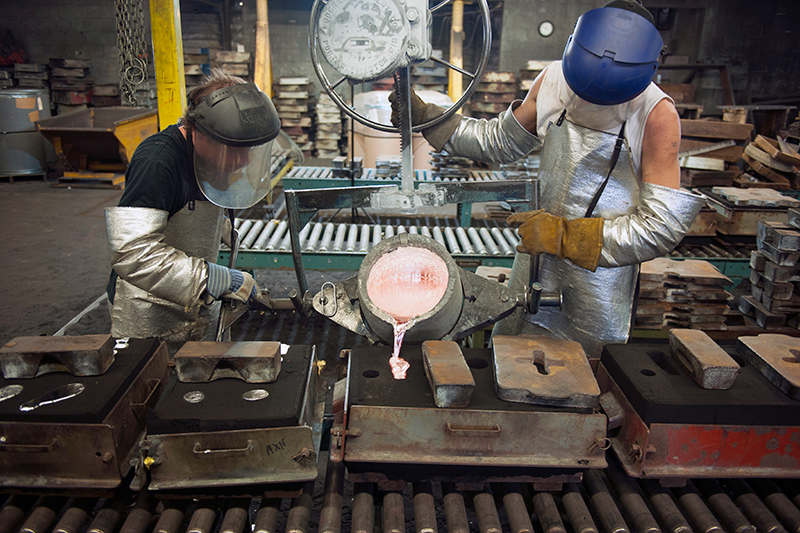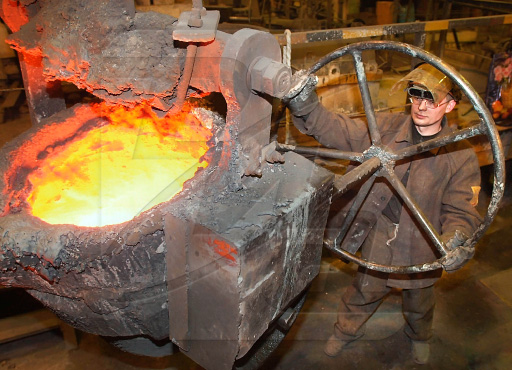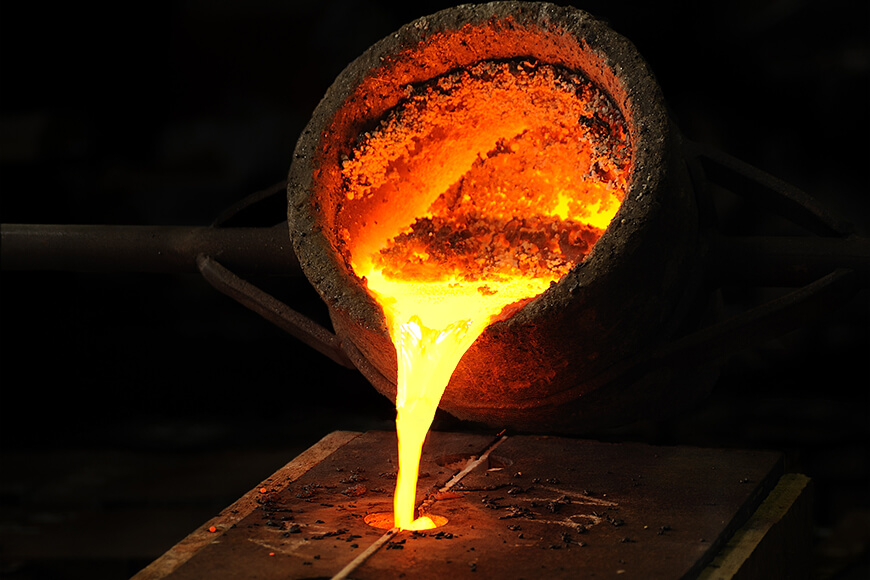How to Select the Right Casting Foundry for Industrial Applications
Checking Out the Essential Role of Casting Foundry in Modern Manufacturing
Casting shops are pivotal in modern-day manufacturing, supplying crucial elements across varied markets. Casting Foundry. Their capacity to generate elaborate, light-weight parts satisfies the growing demands for effectiveness and top quality. Nonetheless, the landscape is developing, affected by technological innovations and sustainability issues. As these factories navigate challenges and opportunities, their future role in production remains unsure. What approaches will they employ to adjust and flourish in this dynamic atmosphere?
The Principles of Casting: Comprehending the Process
Although Casting has been an essential manufacturing process for centuries, its concepts stay important to contemporary sector. This process includes putting a fluid material, usually steel, right into a mold to create a certain shape. The mold and mildew is made to develop the preferred output, which solidifies as it cools. Secret stages in casting consist of pattern making, mold and mildew production, pouring, and finishing. Each stage requires mindful attention to information, making sure that the last item satisfies quality and dimensional criteria.
The flexibility of Casting enables for the production of intricate geometries that would be difficult or tough to achieve through various other producing techniques. Additionally, Casting can fit a range of materials, including steels and polymers. This adaptability makes it an essential strategy for markets varying from vehicle to aerospace, supporting technology and performance in the development of parts that satisfy the demands of contemporary applications.
Sorts Of Casting Strategies and Their Applications
Casting techniques vary, each tailored for specific applications and product needs. Sand Casting is just one of the earliest approaches, suitable for big parts and complicated geometries, utilizing sand molds. Financial investment casting, known for its accuracy, is optimal for detailed styles and is typically made use of in aerospace and medical industries. Die casting, commonly employed for high-volume production, permits fast production of smaller get rid of excellent surface finish, commonly in aluminum or zinc alloys. Covering Casting supplies an equilibrium in between the 2, giving great information and great stamina, making it preferred in auto applications. Irreversible mold and mildew spreading, made use of for non-ferrous steels, supplies a tighter dimensional resistance and far better mechanical residential or commercial properties. Centrifugal Casting is efficient for developing round components, typically located in tubes and pipelines. Each strategy offers distinctive functions, highlighting the convenience and significance of Casting in contemporary production
The Influence of Casting Foundries on Sector Technology
As industries endeavor for higher effectiveness and product high quality, the role of casting foundries comes to be increasingly crucial in driving innovation. These facilities act as the foundation for generating complex parts across various fields, consisting of automobile, aerospace, and energy. By leveraging advanced Casting methods and products, foundries add to the advancement of lighter, more powerful, and a lot more sturdy items that fulfill evolving consumer needs.

In addition, foundries facilitate making use of sustainable practices, such as reusing metal and decreasing waste, which lines up with modern sector requirements for environmental duty. Eventually, the ingenious capabilities of casting shops not only improve manufacturing effectiveness yet additionally drive entire markets right into a future defined by technological improvement and sustainability.

Challenges Facing Casting Factories in a Modern Economic situation
While advancement remains to reshape the production landscape, casting factories face a myriad of obstacles that endanger their operational stability. One significant issue is the enhancing competitors from innovative production technologies, such as additive manufacturing, which can produce intricate get rid of less product waste. Furthermore, the fluctuating rates of raw materials, specifically metals, posture financial risks, impacting price predictability. Labor lacks even more exacerbate these obstacles, as competent employees become harder to maintain and locate in the middle of an aging labor force. Furthermore, regulative stress regarding emissions and workplace safety and security call for foundries to buy costly upgrades, typically straining minimal resources. The requirement for electronic transformation additionally looms big, as several foundries battle to take on Industry 4.0 technologies that improve effectiveness and data management. Jointly, these difficulties force casting factories to adjust quickly or take the chance of obsolescence in a significantly competitive market.
Sustainability Practices in Casting Foundries
In the middle of the obstacles confronting Casting foundries, the fostering of sustainability techniques has become a crucial method for boosting functional durability and competitiveness. Foundries are significantly concentrating on reducing waste with efficient source monitoring, recycling scrap steel, and making use of environmentally friendly products in their processes. The implementation of energy-efficient technologies is an additional important element, as it assists lower energy usage and carbon discharges.
Lots of factories are taking on closed-loop systems to lessen water usage and minimize the environmental influence of procedures. Employee training in lasting practices promotes a culture of environmental duty, making sure that all employee are participated in sustainability campaigns.
Integrating Innovation in Casting Processes
Integrating advanced innovations right into casting procedures has ended up being an essential consider driving efficiency and advancement within shops. Automation and robotics are significantly employed to simplify here manufacturing, reducing labor costs and lessening human mistake. Advanced software for simulation and modeling allows engineers to predict results and optimize designs prior to physical production starts. Furthermore, the unification of 3D printing modern technology greatly boosts the prototyping stage, helping with quick development and minimizing lead times.
On top of that, real-time surveillance systems using IoT tools allow shops to track efficiency metrics and identify possible issues early in the Casting procedure. This data-driven method not only boosts quality assurance yet likewise supports maintenance approaches that protect against expensive downtimes. As an outcome, integrating these innovations cultivates an extra agile production setting, permitting factories to respond swiftly to market demands while preserving high requirements of high quality and sustainability.
The Future of Casting Foundries in Production

In addition, the need for high-performance and light-weight products in fields like aerospace and automobile will certainly drive development within foundries. Collaborations between manufacturers and shops will likely increase, promoting a more integrated supply chain that stresses rapid prototyping and personalization. As electronic makeover proceeds, shops may additionally leverage information analytics to optimize procedures and forecast maintenance demands, guaranteeing competitiveness. Ultimately, the future of casting foundries rests on their capability to adapt to technical developments and market demands while keeping high quality and cost-effectiveness.
Frequently Asked Questions
What Materials Are Commonly Made Use Of in Casting Foundries?
The products frequently made use of in casting foundries include steels such as light weight aluminum, steel, bronze, and iron, along with different alloys. Additionally, sand, material, and ceramic are usually made use of for mold and mildews and core manufacturing.
Just How Do Casting Factories Make Certain High Quality Control in Production?
Casting foundries execute rigorous high quality control actions, consisting of regular inspections, standard screening, and adherence to market accreditations. These practices ensure that each product satisfies defined tolerances and performance criteria, thus maintaining high degrees of dependability and consumer contentment.
What Are the Precaution in Casting Foundries?
Precaution in casting shops consist of the usage of personal protective devices, correct ventilation systems, normal devices maintenance, employee training programs, and adherence to security policies to minimize risks related to liquified steel handling and machinery operation.
For how long Does the Casting Process Normally Take?
The Casting process typically takes several hours to several days, depending on factors such as the complexity of the style, the products made use of, and the cooling time needed important site for the cast components to solidify properly.
What Is the Duty of Designers in Casting Foundries?
Designers in casting factories manage design, procedure optimization, and quality control. They assure that materials fulfill specs, troubleshoot production problems, and execute ingenious techniques, eventually contributing to performance and the successful fabrication of metal parts.
Casting shops are critical in contemporary production, supplying crucial components throughout varied markets. While advancement continues to improve the production landscape, casting factories encounter a myriad of difficulties that intimidate their operational feasibility. In the middle of the challenges challenging Casting foundries, the adoption of sustainability methods has actually emerged as a necessary method for enhancing find out here now operational resilience and competition. In addition, real-time surveillance systems using IoT gadgets make it possible for factories to track performance metrics and determine possible problems early in the Casting procedure. The materials generally utilized in casting shops consist of metals such as light weight aluminum, bronze, iron, and steel, along with various alloys.